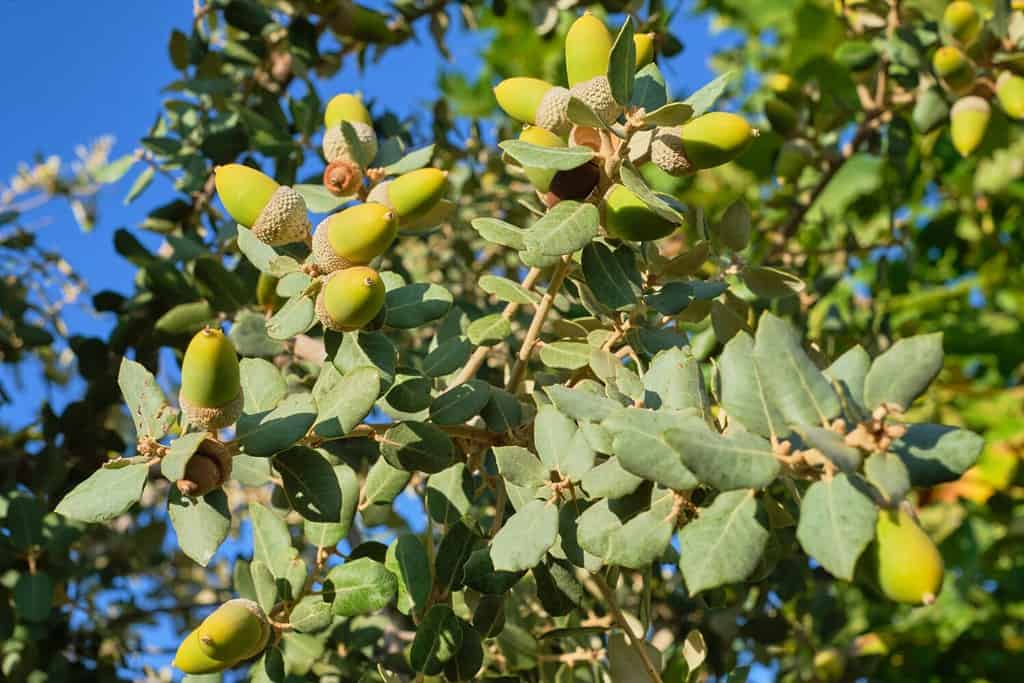When you think of an acorn, what’s the first thing that comes to mind? For many, it’s simply known as a snack for squirrels. However, many people have likely wondered if they’re safe to eat for humans as well. Today we’ll answer this question and explore uses for acorns that lie outside of the realm of squirrel food!
Acorns: A Brief Overview

Many acorns begin falling from trees during the late summer.
©Kasabutskaya Nataliya/Shutterstock.com
What are acorns exactly? Are they nuts, seeds, or something else entirely? Acorns are sometimes referred to as an “oak nut” as they are the fruiting body of oak trees. As any fruit does, after the acorn ripens, it falls to the ground. Under ideal circumstances, the acorn will grow into another oak tree and the cycle will begin again. However, this isn’t the fate of many acorns as many of them are scooped up by animals before they can begin growing. Squirrels, birds, ducks, and mice are all fond of this tasty food.
Is It Safe for Humans to Eat Acorns?

Although many animals eat acorns raw, humans must remove the tannins before consumption.
©iStock.com/suefeldberg
In short, yes, it is perfectly fine for humans to eat acorns. However, preparing them properly is crucial, as they are dangerous to eat raw. Many people find that processing them is quite a tricky and long ordeal, so this may have something to do with their unpopularity. According to The Woodland Trust, “Raw acorns contain tannins which can be toxic to humans and cause an unpleasant bitter taste. They are also poisonous to horses, cattle, and dogs. But by leaching acorns to remove the tannin, they can be made safe for human consumption.”
Is It Easy to Remove Tannins?

There are usually only one or two oak seeds inside each acorn.
©iStock.com/EIBrubaker
Tannins can be removed from the acorns through a process called leaching. Individuals must first deshell their acorns before soaking them in hot water until it turns brown. After this, continue replacing the water and soaking the acorns until the water becomes clear. This process may be tedious, but it will ensure the tannins are removed. For more information on leaching, you can see an in-depth guide on The Woodland Trust’s website. After removal, one of the most popular ways to prepare acorns is to roast them and eat them like nuts. Other people prefer to grind them into a power for use as a flour alternative.
Are Acorns Nutritious?
Whichever way you choose to prepare acorns, one thing is for certain: this snack is very nutrient-dense. Different acorn varieties will provide different nutrients. However, in general, most acorns are rich in iron, potassium, protein, carbohydrates, Vitamin C, Vitamin A, and Vitamin E. Compared to other nuts and seeds, they’re also very low fat and rich in antioxidants. A few acorns per day can serve as an alternative to taking supplements. In addition to all these benefits, acorns are relatively low-calorie, making them an excellent choice for a healthy and quick snack.
Can You Forage Your Own Acorns?

Squirrels will bury many acorns throughout the summer and early fall for later consumption.
©Alber GB/Shutterstock.com
You can certainly forage your own acorns, but you might have steep competition from animals out in the wild! Purchasing acorns from a reputable source is the easiest way to skip the guesswork associated with foraging them in the wild. However, finding your own acorns and processing them is possible as well. For individuals who choose to go this route, avoid foraging any acorns that seem to have holes in them or discoloration. As a rule of thumb, brown ones are usually the ripest, so try to pick those up first. A good way to test whether an acorn is good is to conduct a float test. Only eat acorns that sink to the bottom of a bowl of water.
Why Isn’t Eating Acorns More Popular?

Coffee derived from ground-up acorns was popular during war times.
©Valentyn Volkov/Shutterstock.com
As we stated earlier, the process of preparing acorns can be a long and tedious process. This might be part of the reason why they aren’t more readily available. However, another reason why acorns aren’t on every supermarket aisle is simply because they don’t taste that great. Many people describe the flavor as bland and mild, and if tannins aren’t removed, the flavor is bitter and harsh. Simply put, there isn’t a huge market for them. Despite all the nutritional benefits they provide, other nuts and seeds are more favorable flavor-wise in addition to being nutrient-dense.
Final Thoughts
With so many benefits, it’s a surprise we don’t hear more about people eating acorns these days. Luckily, purchasing or foraging your own acorns is a quick and easy process. Individuals interested in doing so can read more about eating acorns on the International Oak Society’s website.
The photo featured at the top of this post is © iStock.com/EIBrubaker
Thank you for reading! Have some feedback for us? Contact the AZ Animals editorial team.






